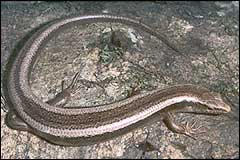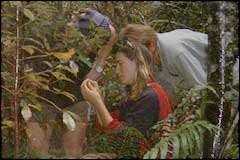|
|
|||
|
||||
|
Updated: September 12, 2001 |
|
|
|||||||||||||||||||||||||||||||||||||||||||||||||||||||||||||||||||||||||||||||||||||||||||||||||||||||
 All native lizards including the striped skink are fully protected |
|
 DoC researchers examine a copper skink from a pitfall trap |
Most New Zealand skinks are active in the daytime - diurnal. They bask in the sun on warm stones to heat both sides of their bodies. They maintain an even body temperature by moving in and out of the sun so they don't get too hot or too cold. This is called thermoregulation.
Skinks are camouflaged so that they are not easily seen in their natural environments. Most are ground dwelling though some live in trees or search for food in shrubs and trees. They look snake-like with their necks merged with their bodies. Skinks have movable eyelids and blink to keep their eyes clean and moist.
Skinks move very quickly and can out run their prey to catch it. They eat a variety of insects, fruit, berries and seeds.
New Zealand's cool climate means that the pregnant female skinks store their eggs inside their bodies. The young skinks hatch internally and so are born live.
The following table is a summary of information about skinks.
|
|
|
|
|
|
Snake-like overlapping scales Tight and shiny Sloughing off skin in small pieces |
Receive warmth Processing UV light for bone growth Growth |
|
|
Moveable eyelid |
Catching prey |
|
|
Large range |
|
|
|
Test the air on tongue |
Detect food, invaders or other skinks Eating and spreading seeds |
|
|
Detaches when caught Re-grows Fat storage |
Stalking prey Climbing Reproductive organs under base in males Winter food reserves |
|
|
Long thin toes rounded at tip Moving quickly |
Running Swimming |
|
|
Live young 2 to 8 in a litter Only Suter's skink lays eggs (3 - 4) |
Warmth for incubation |